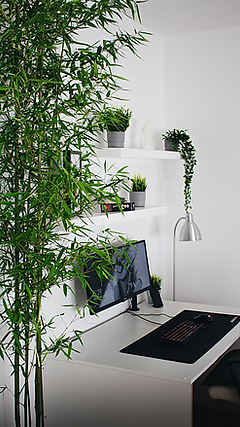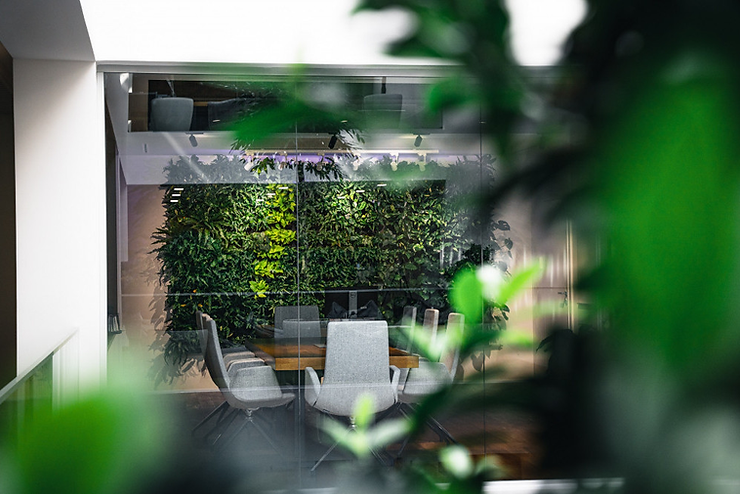
I always thought that plants in an office make for a cheery setting. Not only does the workspace look more inviting, but potted plants in the office also create a more healthy environment. Numerous studies have shown the benefits of plants in offices. So, are plants in the office good or bad? Definitely good. Read on to learn why it is beneficial to scatter live indoor plants throughout your workplace and how it can boost the bottom line.
(Some of the links within this post are affiliate links on which I receive a small compensation from the sale of certain items with no extra cost to you.)
(As an Amazon Associate I earn from qualifying purchases.)
Begin at the Beginning – Biophilia
According to the Cambridge Dictionary, biophilia is the “love of living things and nature, which some people believe humans are born with; the inborn affinity human beings have for other forms of life.” Having things you love around you creates a more calm and friendlier environment.
Studies show the full benefits of nature in our lives. Conversely, the lack of nature can negatively affect individuals. A compilation of findings from various studies on biophilia can be found at the NIH and the Natural Library of Medicine.
The biophilia hypothesis indicates that there are many benefits to having nature surround us, not only in our office but in our homes.
Jumping on the Bandwagon/Plants in the Office
The idea of “biophilia design” is being used throughout many office complexes and industries to boost productivity. Companies are allotting thousands of dollars in their budgets to create areas where their workers can connect with nature. Tall atriums are incorporated into office complexes, along with smaller open areas to create the cozy feeling of nature.

In addition to open spaces, living walls have been affixed to existing walls. Simple additions of plants in pots scattered throughout offices are also used to create the zen of natural surroundings.
Let’s read about how the presence of potted plants in a workplace can positively affect our well-being and productivity.

Aesthetics
Typical office spaces are monochromatic: the same colored furniture; same colored dividers; and same colored walls. Hence, a very sterile appearance. How drab and uninspiring! Add the sight of endless cubicles to the mix and that will definitely spell ugh!
Integrating inexpensive potted plants into these bland spaces will add multiple textures, colors, and interest. Imagine incorporating varying colors of green, gold, red, and yellow to the decor. Voila, instant beauty!
Beautiful plants also make the environment more welcoming. It’s an easy way for employers to invite employees, customers, and potential clients to their place of business. When plants are placed in a reception area, they naturally welcome new customers in a warm and attractive way.
Boosts Wellness
Insufficient ventilation in buildings leads to “sick building syndrome”.
According to the National Library of Medicine and NIH, sick building syndrome is “a situation in which the occupants of a building experience acute health or comfort-related effects that seem to be linked directly to the time spent in the building.” It can cause feelings of nausea, create headaches and flu-like symptoms, and generate difficulty in focusing.
No actual illness or cause can be linked to these symptoms, any or all of which can contribute to absenteeism.
Adding plants to the environment may reduce poor attendance by keeping the environment healthier.
Plants add much needed humidity to the air. Lack of humidity causes many real physical illnesses. Refer to Six Benefits of Indoor Plants for more information.

Promotes Creativity
If you have ever had writer’s block, you know how hard it is to get things flowing. They say to get out of your space and go for a walk in the fresh air. It is supposed to help clear the mind and allow for other thoughts to percolate.
Nature naturally activates our senses. Using senses such as sight, touch, and smell gets our creative juices flowing. Incorporate a variety of plants with different textures, patterns, hues, and smells into your workplace. The softness of a Norfolk pine, the patterned foliage of a calathea, a multi-colored coleus, and/or a sweet smelling citrus tree will tickle your senses and aid creativity.
Promotes Productivity
It has been shown by the American Psychological Association that “workers’ quality of life can be enriched by office landscaping that involves the use of plants that have no formal work-related function.”
Nondescript, “lean” offices were much less productive than “green” offices. Those employees who engaged with the environment (plants) were shown to be more focused and deliver more output.

Reduces Noise Pollution
Have you ever noticed how much quieter it is when you are standing in a forest as compared to an inner city? The reason is trees and foliage. Plants have the ability to absorb extraneous sounds. When they are placed in rooms where there is a lot of concrete, hardwood, and/or marble, the plants tend to soak up the surrounding noises. Plants positively affect the acoustics of a room by capturing, trapping, and dissipating noise energy.
Constant noise can be a distraction and harm productivity. In addition to adding plants to the office floor space, place a shelf on the top of a cubicle wall and add a row of potted plants to help reduce unwanted sound.
Get Premium Plants by Leon & George
Aids in Stress Relief
Many studies have shown the positive effect of plants on stress reduction. In addition to reducing stress, plants can ease anxiety, chronic fatigue, depression, and office hostility.
Plants and biophilia design help provide a meditative state that leads to a happier, healthier, and more productive life.
How to Care For Your Plants
If you decide to add plants in your office space, consider how much light surrounds your desk, where you will place the plant, what type of container it has, and the ease or difficulty of its care
– including how much water it requires. A simple moisture meter from Amazon will help determine when your plant needs water. Read my post, How to Care for Indoor Plants, to learn more.
Below is a great video which describes the how’s and where’s of indoor plants in an office space.
Conclusion – Plants in the Office – Good or Bad?
Having plants in an office is very, very good. Adding plants to a workspace will promote creativity, productivity, reduce excess noise and stress, boost an over-all wellness, and add beauty to an area. Maybe it will even make you look forward to going to work because you will be communing with nature! If you are happy, then your employer is happy. What better way to boost the bottom line?

I hope you have enjoyed this post. Please leave a comment below and share it with friends and family.
Happy Gardening!
Nina
